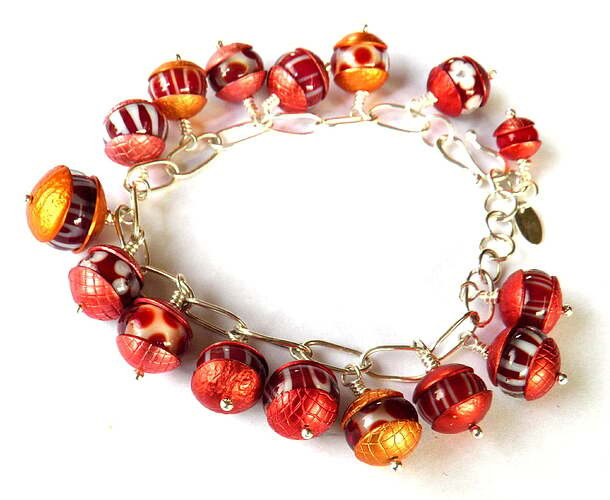Materials: Sterling Silver; Aluminium, Lampworked Glass Beads
Dimensions: 18cm in length
16 handmade lampwork beads capped in anodised aluminium and attached to my handmade sterling silver chain. Lampwork beads are handmade by Lorraine.
Photo credit: Lorraine Allan
Lorraine Allan
Handmade by Lorraine Allan
Adelaide, South Australia. Australia
Lorraine Allan was born in Adelaide, South Australia. Her arts & craft career began in 1985, and up until 2008 worked in many aspects of glass, including leadlighting, glass fusing and slumping, and lampwork glass beads. In 1997 Lorraine participated in several TAFE courses in silver jewellery, and has created many pieces of jewellery over the years.
In 2008 Lorraine became interested in anodised aluminium jewellery. After a great deal of experimenting she enrolled in a course at the Jam Factory with Meghan O'Rourke. Her participation in this course resulted in the problems she had experienced with the anodising process being solved.
Lorraine was a finalist in 'Country Garden' Art Challenge in Beads, Etc magazine in Nov '06 and '2007 Beading Extravaganza Competition' at the Bead and Gem Show in Sydney. A finalist in 'Wearable Expressions 2008' in California, USA. Finalist in 'Fiber Celebration 2008', Colorado, USA. She was selected as the Featured Artist in Australian Beading Magazine in Aug, 2008 and Bead Dreams USA Finalist published in Bead & Button magazine in October, '08. Lorraine wrote an article about a well-known lampwork artist from USA who demonstrated his art at the Jam Factory in Adelaide titled 'James and the Jam Factory' which was published in Australian Bead Magazine in Oct 2009.
Lorraine has displayed her lampwork beads, sterling silver and anodised aluminium jewellery in various art & craft shows in South Australia, New South Wales, Ohio, USA and Wisconsin, USA.
Her current focus is on anodised aluminium jewellery and her latest series of work involves the method of 'foldforming' drawing inspiration from Mother Nature in the designing of leaves.
The exhibition explores metal works whose primary theme is color embraced as their primary visual focus, whether that be using colored materials, exploring creating colored surfaces, or encasing the object in color.
As the world's largest jewelry related internet site, Ganoksin strives to develop exhibitions showcasing work from around the world. This exhibition was open to all metalsmiths, professional and amateur, advanced and beginner.
In total 303 artists contributed 814 show pieces for the permanent online exhibition.
The exhibition was curated by Beth Wicker, President of the North Carolina Society of Goldsmiths in the United States, and Adjunct Instructor at Northeastern Technical College in South Carolina. Director of the exhibition is Hanuman Aspler, founder of The Ganoksin Project, the world's largest internet jewelry site.
Hue is one of the primary properties of color, it refers to the place the color occupies on the visual spectrum. Humans have used hues throughout time, to create cave paintings, to decorate themselves, their clothing and their housing.
Different hues have taken on different meanings throughout time. Gold traditionally has been a color of purity - the metal gold is relatively unchangeable, and the hue of gold has come to stand for gods and goddesses, for royalty, for durability and for purity. Red has often meant love, or passion. Hues often reflect the meaning of the seasons, with pastels referring to spring and the burst of new life after the pale hues of winter. Summer is reflected in vibrant, deep hues, followed by the browning of hues in the fall as plants go to seed and die, and the land turns fallow.
The worth of a hue has often been tied to what is necessary to make the pigment that creates the hue, and the expensive involved in the process. Often created from crushed stones that had to be mined and carried by caravan over thousands of miles, or from fermented roots of plants only grown in certain areas, or the carapaces of rare insects - the creation of hue in a way that could be used by man was an involved and generally expensive process.
In today's world metalsmiths have access to perhaps the widest range of materials and hues in the history of man - and in some of the most affordable ways ever.
This exhibition celebrates hue - color - as an integral, inherent element of the work. We talk of the "richness" of color, and examples of this abound here. One expects hues from the colors of gemstones used in metalsmithing, but we also have hues from some less expected places. Glass enamels are an ancient way of adding color, as are a variety of patinas. Today's artists also use synthetic man-made materials to add color in ways that didn't exist a century ago.
We invite you to enjoy this celebration of hue, and the ways hues and their use have changed over time.
